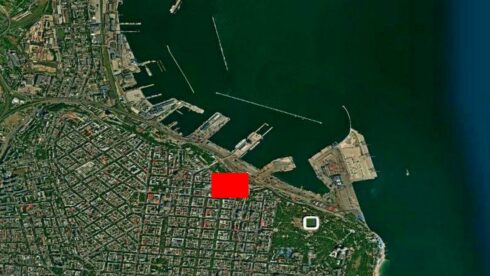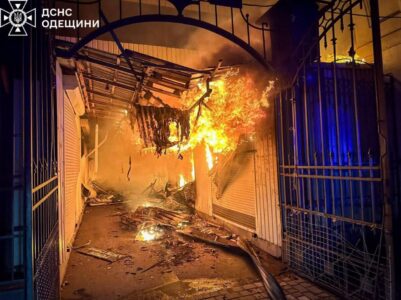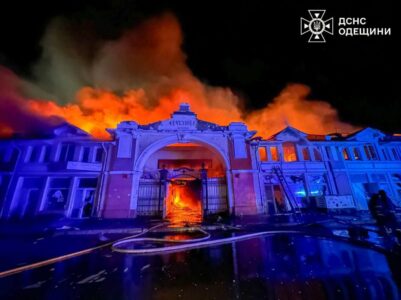The night of July 23-24, 2025 witnessed a dramatic escalation in hostilities as Russian and Ukrainian forces launched simultaneous waves of strikes in each other’s rear regions. The strikes followed another round of negotiations between the two sides in Istanbul. The exchange highlighted both sides’ growing reliance on long-range precision strikes and drone warfare, with significant blows dealt to military and energy infrastructure.
Russian forces conducted another coordinated assault across Ukraine, employing a mix of high-precision weapons including Iskander-K cruise missiles and Geran-2 kamikaze drones. The strikes focused on crippling Ukraine’s military-industrial capacity and energy infrastructure supporting frontline operations.
According to the Air Force of Ukraine, in total 103 UAVs, 4 Iskander-K missiles targeted Ukrainian territory at night. One missile and 90 UAVS were allegedly intercepted by Ukrainian air defense. The ministry of Defense of the Russian Federation confirmed the successful attack, destruction of all the assigned targets.
In the southern Odessa region, Russian strikes were recorded in the city of Odessa and in Akkerman. Russian strikes rocked the port area where NATO military supplies were stored, igniting a massive fire that spread to nearby oil storage facilities. The local Privoz market caught fire reportedly because of the falling debris, sending plumes of smoke over the city center.
In the morning, Russian Iskander missile struck target in Cherkassy. The city is home to more than 10 heavy and chemical industry facilities that have been converted for military purposes. The fire was reported in the Lesya Ukrainka factory area. The Bogdan automotive plant, one of Ukrainian key military production facilities was struck, with local authorities confirming severe structural damage.
The industrial city of Mykolaiv came under sustained drone attack, with strikes reportedly targeting a UAV assembly workshop and multiple warehouses. Emergency services battled fires throughout the night as power outages spread across affected neighborhoods.
In the morning, Kharkiv experienced a new phase in the bombardment as Russian forces reportedly deployed the advanced UMPB-5 glide bomb for the first time, striking an industrial complex adjacent to residential areas.
Ukrainian air defenses engaged furiously throughout the night, claiming interception of one missile and approximately ninety drones. However, the sheer volume of incoming ordnance overwhelmed defensive systems, with impacts confirmed across eleven regions and debris scattering over six additional areas.
As Russian missiles found their targets in Ukraine, Ukrainian forces launched one of their most ambitious drone offensives in months, targeting strategic locations in Crimea and the resort city of Sochi. The attacks employed modified An-196 “Lutyi” drones flying perilously low to evade detection, marking a concerning evolution in Kyiv’s long-range strike capabilities.
The assault began in Crimea, where waves of drones streaked toward Sevastopol, Kerch and Saky, targeting military airbase and other military targets. Russian air defense batteries engaged continuously for over six hours, intercepting the majority of threats though falling debris still damaged residential areas, including a school roof in Sevastopol.
The situation grew more dire when the drone swarm shifted focus to Sochi, where the sleek silhouettes of Ukrainian drones appeared over the Adler district shortly after midnight.
In a carefully coordinated attack, drones weaved through mountain valleys from Abkhazia before descending on oil storage facilities and transportation hubs. The Sirius Federal Territory found itself in the crosshairs as explosions lit up the night sky. A Lukoil fuel depot reportedly took direct hits, sending towering flames across the resort city. The human cost became tragically clear by dawn: at least four civilians were killed mainly by falling wreckage, eleven more civilians were injured. Sochi International Airport suspended all flights, stranding thousands during peak tourist season. Later, it was revealed that
The overnight exchanges revealed both sides’ evolving strategies. Russia continues methodically degrading Ukraine’s capacity to wage war, with strikes increasingly focused on military production. Ukraine’s daring attack on Sochi demonstrates growing confidence in its drone program with civilian-area strikes.
The reciprocal strikes have become almost routine, yet their increasing sophistication and geographic spread suggest neither side has exhausted its capacity for escalation. With peace talks ended in Istanbul but producing no visible reduction in hostilities, the war appears locked in a deadly pattern where diplomatic overtures are immediately undercut by fresh volleys of missiles and drones.










any non white (specially africans and asians) would be beaten to death by the white supremacists of the following organizations: ss aidar, ss kraken, wolfsangel (aka azov), waffen ss nachtigall (who were in kursk killing civilians), leibstandarte adolf hitler, right sektor – all of them hate africans and asians, and all of them are leading the ukrainian government and military. all of them funded by the us and eu tax payers
sounds good, hopefully the africans will stay in africa and the europeans can stay in europe.
thank you for all the great reporting south front!
l’aereo schiantato con civili a bordo tutti morti, ricordate l’elicottero del primo ministro iraniano che si schianto’ , fu fatto cadere con una nuova arma e così pure l’aereo con i civili russi,sappiamo chi ha quest’arma che la usa in modo criminale sia contro aerei civili che militari.
as russia 11 going on 12 years later continues to “fiddle”!….
ukraines military industrial complex is located in europe and the usa and is safe from bombing.
russias military industrial complex is located in russia and is being attacked by european and american weapons.
how does that turn out in the long term?
if russia wanted to wipe it’s russian western neighbor aka “border” off the map it could have done it within the first year of the $0r0$ 0range revolution!… in hindsight i believe it would have gotten more respect -if it had… and probably wouldn’t be facing a western nuclear escalation now 11 years later by the most bankrupted western central banks that don’t care about their own or themselves given the blood and treasure expended these last 14 years alone!…
ukraine is to the east, how can drones come from the east to attack? where are they coming from?
you left out what happened to the drones that were launched from inside russia against it’s own air bases a month ago, let alone what’s been done to kursk… and all of the random acts of terrorism like beslan, crocus hall and destruction of government property the past 20 years by foreign nationals that keep getting welcomed with open arms by the russian federation through a revolving set of door(s)?…
ukraine does not negotiate . just like israel does not negotiate nor make and keep any agreements . expect nothing from the ukrainians but trying to hide failures and collapses . the money presses are still running
minule som pozeral reláciu casus belli. tam spomínali, že rf na začiatku nakúpila od iránu 6000 ks šáhid-136. cena vraj bola cca 190 000 us$ za kus. pritom teraz rf vyrába vlastné v cenovej relácii cca 25 000 us$ za ks. zrejme bola v tom zarátaná licencia!!! rusko totižto dodržiava právo. preto predpokladám, že to platí aj v obchodných vzťahoch. mysleniu zdar a svetu mier!!!
it has been a very “hot” summer in moscow…just like i predicted…heheheh
ur mums arse still smells like cow farts…just like i predicted…heheheh